#faerie faith
Text
To Ward a Natural Space
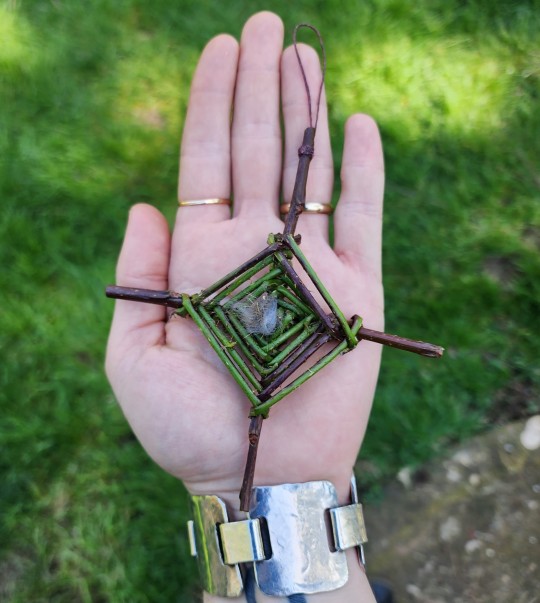

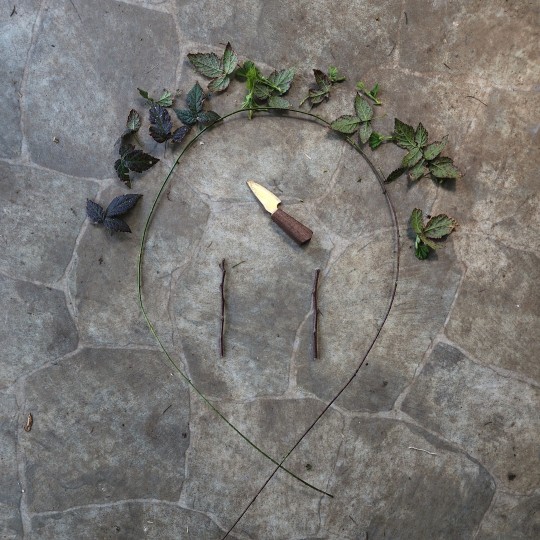
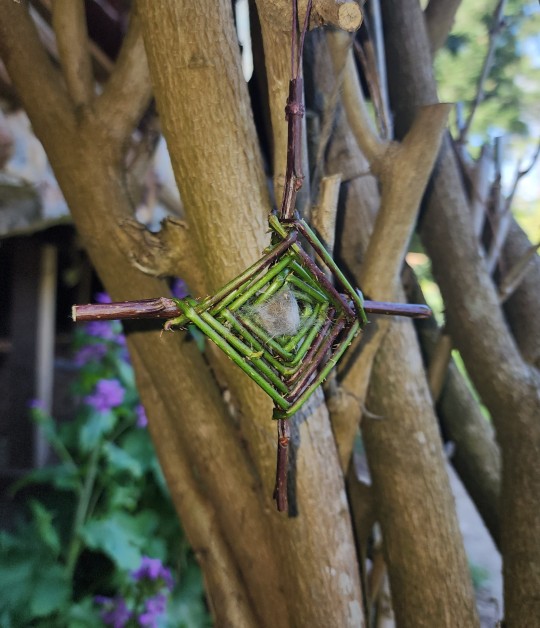
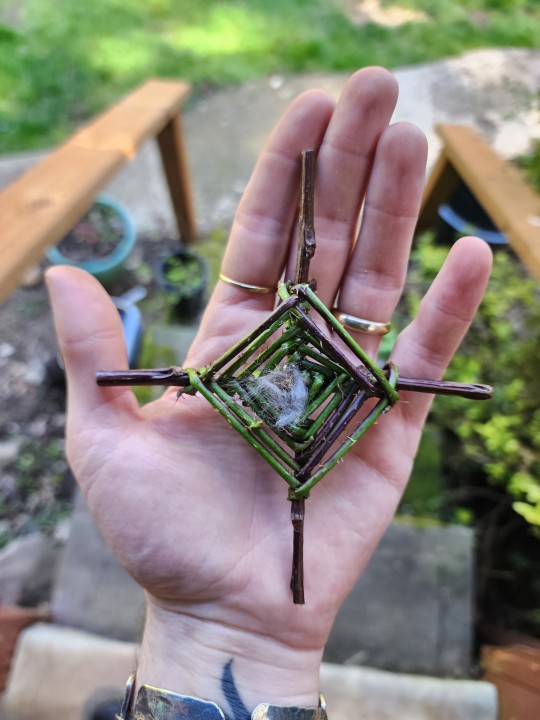

This is a Ward that defends a natural area against those who would disrespect the land. It was taught to me by the Glaoming Folk, and I have since been given permission to share the process in hopes that others might use it to protect their own beloved ecological sites. It is worth noting that this ward only seems to have a range of about 20 to 40 feet, which I realize isn't necessarily ideal, but when strategically placed, multiple wards can be used to create a 'warding net' across an area.
To make this Ward, a switch must be harvested from a propitiated Crabapple tree, which is then split in half to create a pair of sticks measuring approximately the same length. Thereafter, a long and thin runner of blackberry bramble is collected and harvested—ideally from a place with fae activity—and is stripped of leaves. A God's Eye is then woven using the Crabapple sticks and the Blackberry brambles, working one's intent into every turn of the Weaving, before a tuft of Hare's fur is ensnared within the center of the ward. All of this must be done bare-handed, as every prick and drop of blood serves to strengthen the will of the Ward and appease the Spirit of the Blackberry, which lends its power to this magic.
The resultant device can then either be hung with twine, or simply placed in a fitting spot. It has shown itself to be quite helpful in discouraging those who would litter or mar a natural space from doing so. While littering and tree carving hasn't gone away entirely since beginning to use these, it has most certainly dropped significantly—and only in the places where they are employed.
#warding#wards#protective charm#protective magic#protection magic#protection#nature magic#green magic#plant magic#gloaming folk#fae#fair folk#faerie faith#environmental magic
636 notes
·
View notes
Text
To the lovely Baby Witches✨into Sigil/ Rune Magic…

Sigils and runes don’t have to be complicated or strategic! They can be as quick and simple as a doodle on your lunch napkin or strategic shapes and symbols your intuition has shown you.

Charging Sigils/Runes
Meditation
Chanting
Placing them in powerful places, I.e., tattoos, food, entrances&exits
Using them in your rituals/ day to day
Sleeping with them under your pillow
Don’t burn or ignite your sigils unless your intent is to banish!
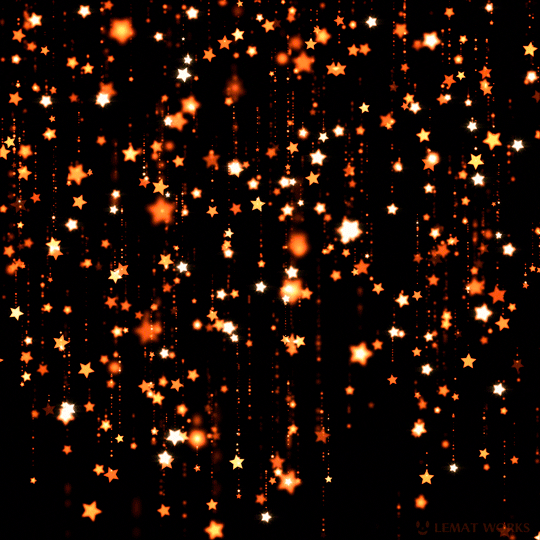
If anyone has questions or wants to chat about witchy things don’t hesitate to hmu! :)
I hope you find endless sweet water and warm winds my friend
~Fae
#witch community#baby witch#witchblr#witchcraft#faery#pagan#paganism#witch#faerie faith#fairy witch#wicca#fairy faith#sigil magic#fairy witchcraft#fairy wicca#eclectic witch#chaos magick#magick#magic
24 notes
·
View notes
Text
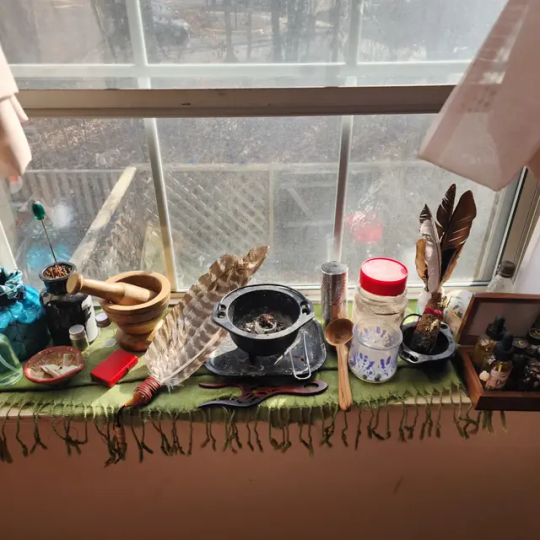
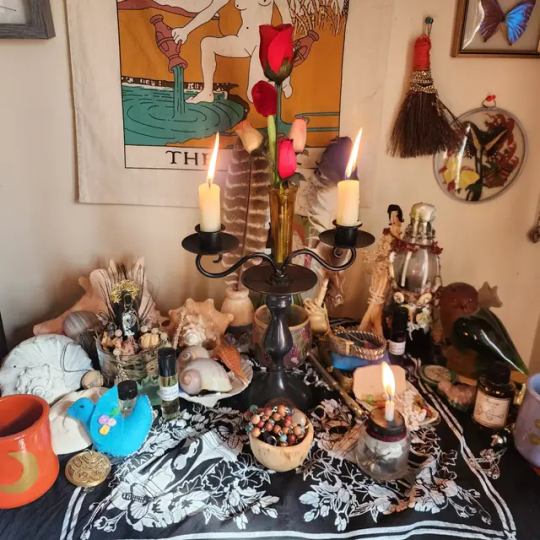
Refreshing my altars and shrines, and updating my wards... I've been in a bit of a magical rut for the last few weeks and figured it was time to update everything since my practice has changed significantly in the last few months. My shrine space now focuses on my faerie faith and the sea spirits themselves that I work with on the ship, as well as space for the spirits I specifically work with and my ancestors, and my working altar has been cleaned and prepped for magical workings again, now with new supplies mostly gifted by people I love.
#folk magic#appalachain folk magic#faerie faith#traditional witchcraft#folk witchcraft#altar space#window altar#shrine space#genus locii#cleansing
24 notes
·
View notes
Text
Hi witches! I’ve been reading up on traditional witchcraft and am very interested in the Faerie King aspect/guise of the Witch Father (and I suppose by extension the faerie faith). I was wondering if anyone had any resources or information they would be okay with sharing to point me in the right direction 人(_ _*)
#traditional witchcraft#trad craft#the witch father#the king of elphame#the faerie king#fairy faith#faerie faith#faerie witch#witchfather#folk devil#the witches’ devil#the horned god#the horned one#faery faith#robin goodfellow#folk magick#folk witchcraft
23 notes
·
View notes
Text
Flowers & Ash's first event since moving servers is taking place this Saturday, June 24th at 1:00 PM EDT / 6:00 PM BST. As a reminder, we will be discussing the five following short stories from Fairies And Folk Tales Of The Irish Peasantry by W.B. Yeats. The stories can be found free in digital format on SacredTexts.com or purchased in various formats.
The Demon Cat by Lady Wilde
The Piper And The Puca by Douglas Hyde
The Radiant Boy by Mrs. Crow
Frank Martin And The Fairies by William Carleton
Bewitched Butter (Queens County) by Unknown
We hope to see you then!
Disclaimer: Sacred Texts legally publishes stories which are in the public domain only. F&A is also not affiliated with the website or it's creator in any way.
#discord server#faerie faith#fae folk#faeries#witchcraft#paganism#sacred texts#w.b. yeats#official f&a discord
5 notes
·
View notes
Text
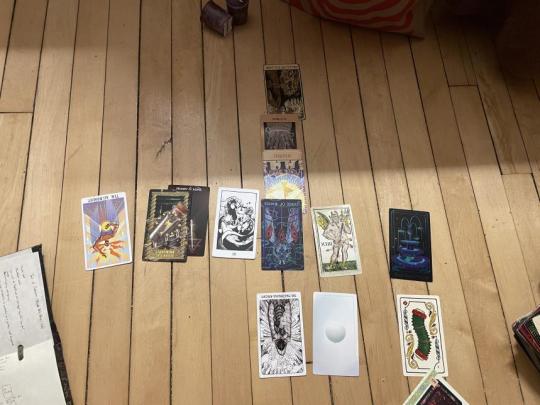

Upon bringing out my tarot deck to ask a few questions about the matter at hand, I found several cards "jumping" out of the deck. I allowed them to arrange themselves into a pattern/spread, and what follows is my interpretation.
We begin with The Allbright, reversed: there is a difficult time, causing me to step up as a hero/vigilante figure. As the question specifically was asking about my Craft, this refers to me stepping up to a role as an intercessor between the Folk and others in this general area, after a period of hardship.
Next, Lightning in a Bottle, informing the Queen of Swords: creation and chaos will leave me craving direction and a painful search for order.
3 of Cups means I'll be connecting or reconnecting with new or old friends, which makes sense as I just moved back to a place I haven't been in years.
Next is the core segment of the reading. Hemmed on either side by Deals in the Dark (Otherworld aligned, Fae work, Shadow work, overcoming fear, and finding substance in the twilight and darkness) and Masterless Knight (Fae work, Otherworld aligned, referring to a mystery figure from a mystery place, guiding me). The 10 of Wands suggests a burden, difficult, and stress that I must carry to completion. Judgement a spiritual awakening and ecstatic change, all informing a distinct openness to new ideas and good things ahead overall.
The Devil with Snakes is paired with The Fountain: Embrace of the liminal/obscene/profane will lead to great relief
The Empty is paired with Ace of Bandoneons: out of nothing will grow a newfound sense of humanity.
1 note
·
View note
Text

Midsummer Eve, Edward Robert Hughes (1908). Private collection
#art#art history#painting#artists on tumblr#aesthetic#fairy tales#fairies#fairy#fantasy#faith#fairy cottage#fair folk#fairy aesthetic#fairycore#faithoverfear#faerycore#fae#faerie#faeries#fae folk#forest fae#fairy art#faery aesthetic#faery folk#peintre anglais#peinture#peintre#arte#pintura#aquarela
769 notes
·
View notes
Text
Misconceptions About Fairies
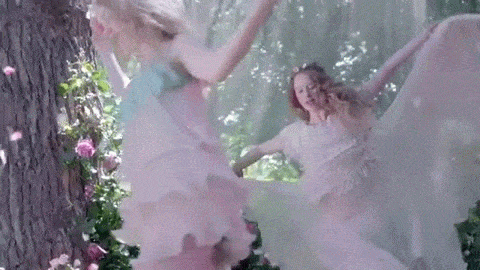
Lately I've been seeing a lot of buzz around the Good People on social media, as well as in my local witchy community. I've also seen a lot of misinformation being passed along and people being encouraged to dive in the deep end without knowing what they're getting into, so I want to address some common misconceptions and spotlight some resources I know are legit.
I've said it before and I've said it again: with the Good People, perhaps more than any other type of spirit, it's very important to know what you're doing before you start reaching out to them. They operate on rules and ethics that are very different from ours, and even the most benevolent of them may be offended or angered by ignorance or bad manners. You cannot skip the reading when it comes to working with these beings. If you're not willing to do the research and make an effort to follow the rules, this is not a crowd you should be messing with. I don't say this to scare people or to discourage people who genuinely feel called to establish a relationship with the Good People. I just want to be clear that with this crowd there are risks, and most of those risks can be addressed by making sure you're prepared.
In this post, you'll see me refer to this class or grouping of magical beings as the Good People, the Other Crowd, the Good Neighbors, or similar euphemisms. This is because the word "fairy" is widely considered offensive, and using it may anger the Good People. My advice is to use your own euphemisms in order to be polite, even in casual conversation -- avoid "the f-word" as much as possible. However, I will be using Fairy (with a capital F) as the name of the realm or plane where the Other Crowd lives.
Now, let's start by addressing those misconceptions, shall we?
1. The Good People are nature spirits.
This is one that I've been guilty of spreading in the past. This one is tricky, because some of the Other Crowd could be considered nature spirits, but not all of them. It's important to remember that "fairy" (and more polite euphemisms) is an umbrella term for many different types of beings. It's about as specific as "animal." And just like some but not all animals are mammals, some but not all of the Good People are nature spirits.
As a whole, the Good People don't seem particularly attached to nature, although some of them tend to avoid humans and end up in wild natural settings as a result. However, true nature spirits are connected to a place or natural feature the same way human spirits are attached to our bodies, and this doesn't seem to be true for the Good People.
2. The Good People are angels and/or spirit guides.
This one usually shows up in the context of New Age spirituality, but the association between angels and the Good People is actually much, much older. When the people of the British Isles converted to Christianity, they tried to reconcile their belief in the Other Crowd with Christian cosmology. Usually, this meant identifying the Good People with devils, but some people identified them as fallen angels. One version of the Christianization of the Good People describes them as angels who refused to pick sides in the war between God and Satan and are exiled from both Heaven and Hell.
I've seen New Age authors like Doreen Virtue describe the Good People as "earth angels" or say that, like angels, they are "high vibrational" beings of pure love and light. This directly contradicts folklore, which describes the Good People as beings with physical bodies with a wide range of attitudes towards humans. The Good People could be helpful allies, mischievous pranksters, or cruel predators. Even the ones who seem to like humans aren't especially pious or virtuous, and they definitely aren't interested in our spiritual development.
The idea of the Good People are spirit guides reduces these beings, who are their own people with their own personalities, goals, and agendas, to servant spirits whose only purpose is to help us grow and learn. That's a pretty self-centered approach to spirituality, and it's honestly one that I don't think many of the Good People would put up with.
3. The Good People are tiny and have wings.
I mean, some of them sort of look like this? There are folkloric accounts of beings that are between 6 and 18 inches tall, but as far as I can tell the wings are a modern development. Descriptions of tiny winged people who are small enough to take a nap inside a flower are a Victorian English invention, as popularized by the Cottingley Fairies hoax, a series of faked photographs that supposedly showed a real Otherwordly encounter:

Most older descriptions from Ireland, Scotland, Wales, and Britain describe the Good People as looking similar to humans or animals. They might look like normal people except for being totally green, like the Green Children of Woolpit or the Green Knight that appears in Arthurian legend. They might be dressed in green and/or red. In folklore the Good People typically wear contemporary clothing, so if you saw one today they might very well be in jeans and a T-shirt. Sometimes in folklore, the Good People are indistinguishable from humans.
Some of the Other Crowd appear as animals, but there's often some sort of tell that indicates an Otherworldly animal, like a kelpie appearing as a horse whose mane is always dripping or the púca appearing as a black horse with glowing golden eyes. Some of them don't look like humans or like animals and are clearly Otherwordly in appearance, like trows, trolls, and goblins.
4. The Good People are All Friendly to Humans
Again, some of them are. Some of the Good People, like brownies, choose to live in humans' homes and communities and actively help out around the house. Then there are others, like the Baobhan Síth, hags, and red caps that prey on humans, sometimes literally. Many of the Good People seem indifferent to humans.
The problem with this is that when you invite the Other Crowd into your home, you're inviting all of them into your home. This is why I personally prefer to work with the Good Neighbors outside my home -- we have an elder tree (a species associated with the Good Neighbors) growing on the edge of our property, and I use this as a place to leave offerings for them. This way I'm showing respect for them and offering gifts in good faith, but I'm not opening up my home.
Another option is to invite specific individuals or types of the Good People in by name. For example, there are things you can do to attract a brownie. I do want to note that even beings that are usually friendly, like brownies, can be dangerous if you piss them off, so you should only invite them into your home if you're willing and able to commit to keeping them happy.
5. You have to be psychic or have the Second Sight to interact with the Good People.
First of all, I firmly believe that all people have the potential for psychic abilities and that anyone can develop these gifts through practice. In folklore there are ways of developing the Second Sight, if that's something that is really important to you. (Just be aware that some of the Good People prefer to be unseen and can take offense to humans trying to look into Fairy.)
But you don't need the Second Sight or experience with psychic practice to interact with the Good People. Most of the people who historically worked with these beings did not have the Sight. You can still leave offerings and see evidence of their presence, and if you really want to communicate with them directly you can use a divination tool.
Further Reading/Viewing:
Fairies: A Guide to the Celtic Fair Folk by Morgan Daimler
Fairy Witchcraft by Morgan Daimler
Faery: A Guide to the Lore, Magic, & World of the Good Folk by John T. Kruse
"Faery Magick Misconceptions | Working with the Fae | Witchcraft" by HearthWitch on YouTube
"What Do We Call the Fairies in Ireland?" by Lora O'Brien on YouTube
"5 Common Misconceptions About Fairies" by Morgan Daimler on YouTube
(I've made a playlist of videos on the Good People I find helpful, which you can watch here!)
#the good people#fairy lore#fairy#fairies#fairycore#fae#the fae#faery#faery aesthetic#faery faith#fairy faith#baby witch bootcamp#baby witch#witchblr#witch#witchcraft#witchy#spirit work#spiritual#spirituality#land spirits#animal spirit#nature spirit#fairy wicca#fairy witch#feri#cottagecore#green witch#green witchcraft#garden witch
900 notes
·
View notes
Text
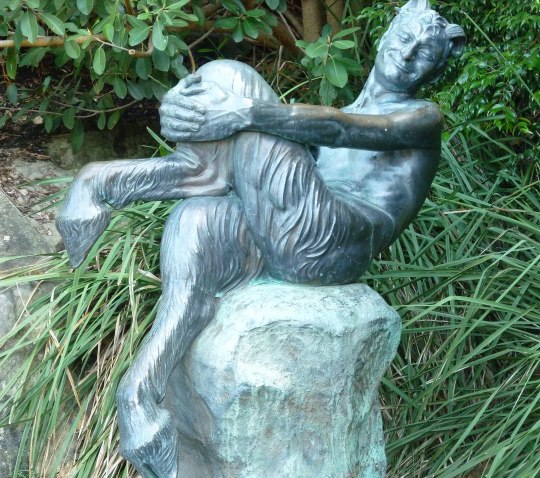
Satyr Sculpture By Frank Lynch (1924) 🍇🤘🖤
Royal Botanic Gardens in Sydney, Australia 🇦🇺🌿🌸
Picture taken on April 24, 2016 📸✨
Wikimedia Commons
#satyr sculpture#satyr#Frank Lynch#royal botanic gardens#sydney#australia#dark pagan#dark paganism#demonolatry#theistic satanism#satanic witch#witchblr#witchcraft#paganblr#spiritual satanism#left hand path#occult#faery faith#demons#dark art#sculpture#pagan#paganism
90 notes
·
View notes
Text
Some animistic bone-reading tips
I've been practicing bone-reading for about five years now, and through that I've picked up on a few things that I don't regularly see people talking about, so I decided to put together a list that I would have personally found helpful at the beginning of my divination practice. Please be advised that I come at bone-reading from a very animistic perspective, so if that's not a viewpoint that you believe in, most of these tips probably won't be helpful to you.
The method of bone-reading I use is to ask a specific question and toss the bones to read. This is a common method, but there are also alternate practices, such as tossing bones in the fire and reading them based on the burns and heat cracking.
Choose your bones carefully. Pick ones that want to be worked with, and ones that you're personally able to resonate with. Bones that don't want to be read can't be used effectively from my experience.
Feed your bones. This is the practice of giving your bones offerings to maintain their willingness to work with you and to build your relationship with them. I find divinatory herbs and blood to be a great offering, though blood should not be used without experience and caution. Food the animal would have eaten while alive can also be effective (for example, if your set is made primarily of fox bones, a small offering of meat might be appreciated).
Listen to your gut. Bone-reading is an incredibly instinctual and personalized form of divination. Don't try too hard to logically assign meanings to your bones - from my experience, they will usually let you know. If you can tell a bone would like to be used for a reading but can't tell what the bone might mean, add it to your set. It will let you know once you start doing readings with it.
Use a mat. This is partially a mundane recommendation; if you throw your bones straight onto the floor, they're eventually going to break. This also makes it easier to tell when a bone breaking is significant to the reading. A mat can also serve as a center of the reading; the bones in the middle may be more significant, whereas the bones that fall off the mat may be irrelevant to the reading. This isn't a format one has to use, but it can be helpful, especially to beginners.
Just start bone-reading. Obviously you should go into it having done research, and with a cautious and respectful attitude. However, at a certain point, doing research and preparation isn't helpful. Because bone-reading is so personalized and instinctual, there is so much you can only learn once you start. During your first few readings, pay close attention to each bone, where they fall next to each other, and what they may be telling you about their meaning.
#bone reading#bone divination#osteomancy#divination#trad witch#traditional witchcraft#witchblr#crooked path#animism#faery faith#folklore#folkloric witchcraft#faery witch#folk devil#folk magic
124 notes
·
View notes
Text
My Ladye hath a sable coach
With horses two and four
My Ladye hath a gaunt blood-hound
That goeth on before.
My Ladye's coach hath nodding plumes
The driver hath no head.
My Ladye is an ashen white
As one that long is dead.
Songs of the West: Folk Songs of Devon & Cornwall Collected From the Myths of the People. S. Baring-Gould. 1913.
195 notes
·
View notes
Note
hello,
this may sound like a silly question, but is it possible for someone who is not Irish, scottish, or British to be contacted by the Fae?
thank you!
Hello there.
This isn't a silly question, but it's one I will have to expound on a bit, as opposed to just giving a yes or no answer. I'll also preface this by saying that my personal beliefs will likely be contentious to some, and I encourage readers to take what they find useful and leave the rest if it conflicts with their own paradigm. Most of this comes from a mixture of personal gnosis and theory, and I am not attempting to assert authority on the subject or claim academic accuracy, so please keep that in mind.
To put it very simply, I believe that the Fae are present in every region of the world, and I have highly syncretic beliefs about the nature of the Fae and other spirits in general. For me, the folkloric specifics come down to cultural lenses and the ways that long-term worship and perception shape the expectations and manifestations of the Gloaming Folk. So, no, I don't think one has to be Gaelic or Brythonic in order to cultivate a relationship with the Fae.
For instance, when looking at the Faerie Faith, many people think primarily—if not only—of the insular Celts. The Fair Folk of the English; the Aos Sidhe of the Irish; the Daoine Sìth of the Scottish; the Sheeaghan of the Manx; the Twlwyth Teg of the Welsh; the Spyrysyon of the Cornish; and the Korrigan of the Breton. But in the larger context of Germanic and Scandinavian folklore, there is copious evidence of entities that are undeniably similar to the Fae as they are understood in the Insular Celtic Isles. In fact, the Germanic word Elf is so closely aligned with the term Faery that many people don't even realize or think about the fact that they derive from different cultures. That being said, the Germanic/Scandinavian "lens" of Faerie Lore is probably the other best known by the wider public.
Likewise, there are multiple beings that show up in Slavic mythology and folklore—such as the Vila, the Rusalke, or the Vodyanoy—which are pretty readily accepted as Faeries. I don't know of an overarching term that would necessarily be equivalent, but the folkloric link is still there.
Now, moving into a more controversial aspect of my beliefs, I also happen to think of Angels, Demons, and Djinn in terms of Gloaming Spirits. While I readily admit that millenia of regionally specific belief and veneration form unique "identies" that Spirits of a given culture may align more closely with, I believe that they are all part of one larger "family" of beings who have been interacting with humanity for many thousands of years. I realize that this will likely be considered an egregious oversimplication for some, or possibly even an erasure of the individuality these cultures possess; but for me, the things that make a tradition sacred and unique are not invalidated or snuffed out by by the fact that other cultures may find recognition in them. So, while I do think beings like Angels, Demons, and Djinn are inexorably interrelated, I also fully accept that they are unique and culturally specific. And frankly, I find it hard to believe that others who have engaged in intensive personal gnosis haven't come across similar threads of paradoxical interconnection.
Beyond these, though, I've also pinpointed other entities over the years that I think represent reasonable approximations of the Fae. These include things like:
The Peris of Persian Mythology (Beautiful aerial spirits sometimes known to work with humans called Peri-Kahn, who gained skills and abilities from the relationship. They are generally described as humanoid figures with beautiful wings, who are known for their michevious behavior, though at least one work references them as divine beings denied entry into paradise until such a times as they have atoned—a folkloric motif some will recognize in connection to certain folk-beliefs regarding the Angels and the Fae.)
The Yakshas of Hinduism, Buddhism, and Jainism (Spirits of nature often connected with water, fertility, plants, treasures, and the wilderness. While some are considered benign or benevolent, others are considered more mischevious or sinister, though most are considered capricious. Sometimes associated with ecological forces, and at other times, with the spirits of the dead. )
The Yōkai of Shintō (A diverse array of spirits—often explicitly equivacated with fairies, demons, and/or sprites—known to interact with humans in both benevolent and malevolent capacities. While many of these spirits are quite singular in their uniqueness, others are more recognizable within a broader archetypal folkloric context—such as the Zashiki-warashi, which are described as diminutive domestic sprites known for both their ability to bestow good fortune, and their tendency to perform mischevious pranks.)
The Korpokkur of Ainu Mythology (A race of little folk, associated with the Butterbur plant, who were said to leave gifts under cover of night—as they did not like being seen. They were believed to be the original inhabitants of Japan before the Ainu—which also echoes aspects of Celtic Faerie Lore.)
The Aziza of Dahomean Mythology (A race of supernatural little folk who are said to live in the Wilds—often beneath Anthills or within silk-cotton trees— and use their magic to help humans, as well as providing people with practical knowledge and spiritual wisdom.)
The Yumboes of Wolof Mythology (Spirits of the dead described as little folk with pearly white skin and silver hair who lived beneath hills and come out to dance beneath the Moonlight. They are known to hold great feasts, which humans are sometimes invited to.)
The Hellenic Nymphs, Sirens, and Kobaloi (As many know, Nymphs are animistic spirits of nature, considered beautiful, and known to interact with humans. Likewise, most will have heard of Sirens as beautiful, seductive, and dangerous spirits of the water who are known to entice and drown men. The Kobaloi, in turn, are described as a mischievous race of small goblin-like folk who are fond of playing tricks on human kind.)
The Basque Iratxoak, Laminak, and Mairuak (An Iraxto is a type of domestic Imp or Goblin known to help with human labors in the night, if properly propitiated. A Lamina, on the other hand, is a Water Maiden described similarly to Sirens or Nereids. They are generally understood to have webbed duck feet and long beautiful hair, which they are fond of combing by the waterside. They are known for both their tendency to offer aid to those who show them respect and propitiation, and their tendency to seduce and ensnare men. Some traditions speak of male giants called Mairuak, who are closely associated with Laminak, and are linked by some with the construction of megalithic structures.)
The Duende of Iberian mythology (A term quite similar to 'Faery' in its usage, which encompasses a diverse array of spiritual entities who are generally said to appear as humanoid, though frequently capable of shapeshifting. They are often associated with nature and are known for their involvement with humans—be it helpful, romantic, michevious, or vicious. They include goblin-esque folk known as Trasgu, Water Maidens known as Xana or Anjana, and supernatural beings called Mouros who take refuge beneath the earth and rarely emerge near sites like barrows. The most common conception of a Duende, however, describes them as a mischevious sort of domestic imp or goblin known for their dealings with the human world. )
The Aztec Chaneque (A sprite-like race of little folk who are associated with Elemental forces and are often conceived as guardians of nature. These beings were once propotiated by the Nàhuatl peoples in exchange for protection from blight, intruders, and evil forces. However, they could also inflict harm, and they were known to sometimes kidnap humans and take them to their home in the Underworld of of Mictlàn to be seduced. On an interesting sidenote, one folk-method of protecting against them when traveling in the forest was for a person to turn their clothing inside out—a charm many will recognize from Celtic Faerie Folklore.)
The Mayan Aluxo'ob (Spirits recognized in the mythological traditions of certain Maya peoples, who are generally associated with particular features of nature. They are described as small and humanoid, and they usually remain invisible, though they can assume physical form for the sake of interacting with humans. Sometimes, wandering Aluxo'ob are said to ask for offerings from farmers or travelers and may respond with wrath if refused. If its conditions are respectfully met, however, it is said that an Alux will provide protection, luck, and aid. In fact, some traditions hold that a farmer can erect a specialized form of Spirit House in order to welcome in an Alux that will aid them for a contracted period of time with tending crops, summoning favorable weather, and guarding property. What's more, there exist naming taboos that reflect themes of Celtic Faerie Lore.)
The Guarani Pombero (A spirit particularly important in Paraguay, though it appears in multiple mythological traditions from the surrounding area. The Pombero is generally conceived as a small hairy man who lives in forested areas and abandoned sites, and is known to cause mischief for humans. It is said that the Pombero can become invisible, change shape, and perfectly mimick the sounds of the wild. Usually, he is considered harmless, if mischevious—known for antics like food theft, the loosing of cattle, and the scattering of household objects. Though, he is also known also known to occasionally abduct and/or impregnate women, resulting in the births of hairy children. The Pombero is capable of being appeased, however, through offerings such as cigars, liquor, and honey. It is even said that, if these propitiations are observed consistently for long enough, the Pombero will take a liking to a person or persons and provide protection for their home and posessions, as well as leaving gifts of their own in return.)
The Tupi-Guarani Curupira (A spirit described in the folklore of Paraguay, Amazonia, Brasil, and Argentina as a little man with bright red hair and feet turned backwards, which it uses to obfuscate the trajectory of its footprints. They are said to live in the wild, and will prey on hunters who take more than they need, or who harm animals while they care for their Offspring. They are also said to ocassionally abduct and/or impregnate women, resulting in strange or unexplained births.)
The Iroquois Jogah (A race of magical little folk spoken of in Iroquois lore. They are said to be largely invisible, and an array of phenomena are associated with them, such as mysterious drumming noises, rings of bare earth, disembodied lights, and "bowls" found in stones. Offerings such as tobacco and fingernail parings could be left within these stone bowls, as propitiation to the Jogah. They are fond of mischief and games, though they can also be dangerous if disrespected. It is said, for example, that they will cause illness in homes constructed upon sites that they favor. The Jogah are also known for the variety of sub-groups into which they can be divided, generally associated with particular aspects or features of the natural world.)
& the Māori Patupaiarehe (Beings described in Māori mythology as a pale folk with red or golden hair. They are said to live in the mountains, hills, and deep forests in communities unseen by human eyes. They are known to influence the mist and clouds, to play music sweeter than that of any human hand, and were said to sometimes act with hostility towards humans who encroach or intrude upon their land. Despite this, however, most traditions state that Māori are able to converse with them at times.)
These are only a selection of traditional beliefs, though there are many more I won't attempt to list, and who knows how many more I've never heard. These are merely ones that have particularly caught my notice over time, and which seemed worth mentioning here. However, I am far from an anthropological expert, and I encourage others to ammend, contextualize, and add onto this information as they see fit—especially if they come from a culture I reference here. My goal is not to imply that all of these traditions are somehow directly connected to the Anglo-Celtic traditions, or that Anglo-Celtic mythology should be the cornerstone by which all folklore is considered; it's just the cultural background I have the most personal connection to/understanding of, and so I aim to speak mainly from a place of my own experience (though, I am actually half Paraguayan as well.)
So, in conclusion, while I do think that one's own cultural and regional context generally plays an important role in how one is likely to encounter the Gloaming Folk, I believe that people from virtually every culture have the capacity for working with them. I think that, when attempting to approach the Fae, it's a good idea for one to come at it from the perspective of their own heritage and regional lore, but at the same time, one can't always help the way spirits end up cultivating relationships with them (and, honestly, I think it is better for one to wait for the Fae to approach them whenever possible.)
#fae#fair folk#gloaming folk#gloaming#otherworld#faerie folk#faerie faith#good neighbors#pagan syncretism#syncretism#faerie lore#faerie folklore#anonymous#ask
200 notes
·
View notes
Text
🌺🧚♀️🌿 Welcome, Fairy Lovers, Enthusiasts and Believers to Fae Friday! 🌿🧚♀️🌺
˚✧₊⁎᷀ົཽ⁎⁺˳✧༚ ˚✧₊⁎᷀ົཽ⁎⁺˳✧༚ ˚✧₊⁎᷀ົཽ⁎⁺˳✧༚ ˚✧₊⁎᷀ົཽ⁎⁺˳✧༚ ˚✧₊⁎᷀ົཽ⁎⁺˳✧༚ ˚✧₊⁎᷀ົཽ⁎⁺˳✧༚ ˚✧₊
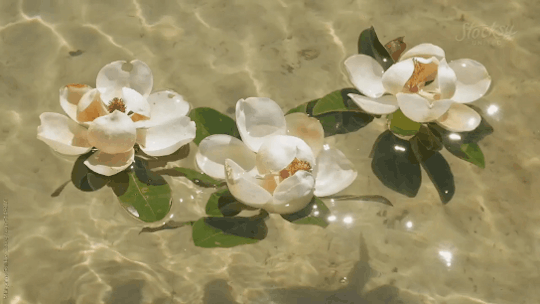
I came up with the idea of Fae Fridays to share with you the wonderful opportunity to celebrate the enchanting energy of the fae realm and connect to the magic that fairies bring into our lives through art, poems, literature and anything else I find captivating and wish to share with you.
˚✧₊⁎᷀ົཽ⁎⁺˳✧༚ ˚✧₊⁎᷀ົཽ⁎⁺˳✧༚ ˚✧₊⁎᷀ົཽ⁎⁺˳✧༚ ˚✧₊⁎᷀ົཽ⁎⁺˳✧༚ ˚✧₊⁎᷀ົཽ⁎⁺˳✧༚ ˚✧₊⁎᷀ົཽ⁎⁺˳✧༚ ˚✧₊

Here are some ideas to infuse your Fridays with the Shining Folks whimsy and charm:

Fae Garden Magic: Set aside some time on Fae Fridays to tend to your fae garden. If you don't have one yet, this is the perfect opportunity to create a miniature garden filled with tiny plants, fairy houses, and whimsical decorations.
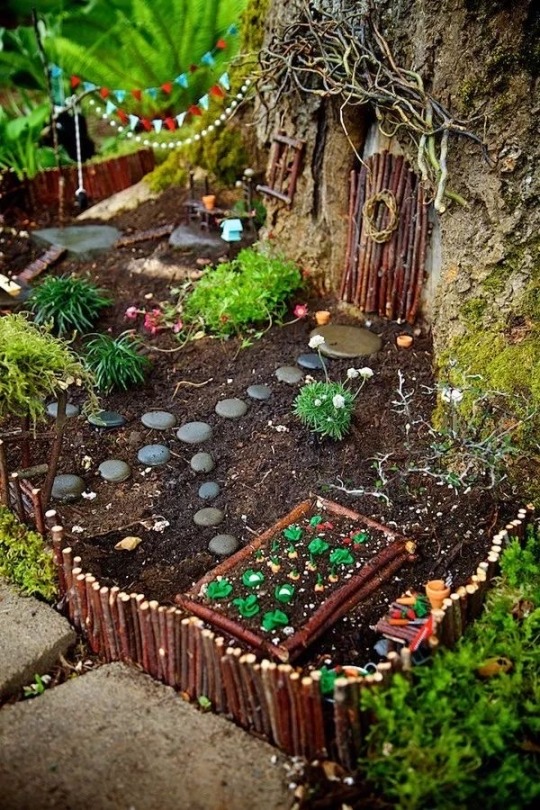

Fae Crafts and Creations: Engage in creative activities inspired by fairies. Faery wings, create fae-inspired art, or craft your own faery house using natural materials. Let your imagination run wild and allow your inner child to play and create.

Fae Oracle or Tarot Readings: Pull out your favorite fae-themed oracle or tarot deck and do a reading specifically focused on connecting with the energy of the fae. Allow the cards to guide you and offer insights into the otherworld.
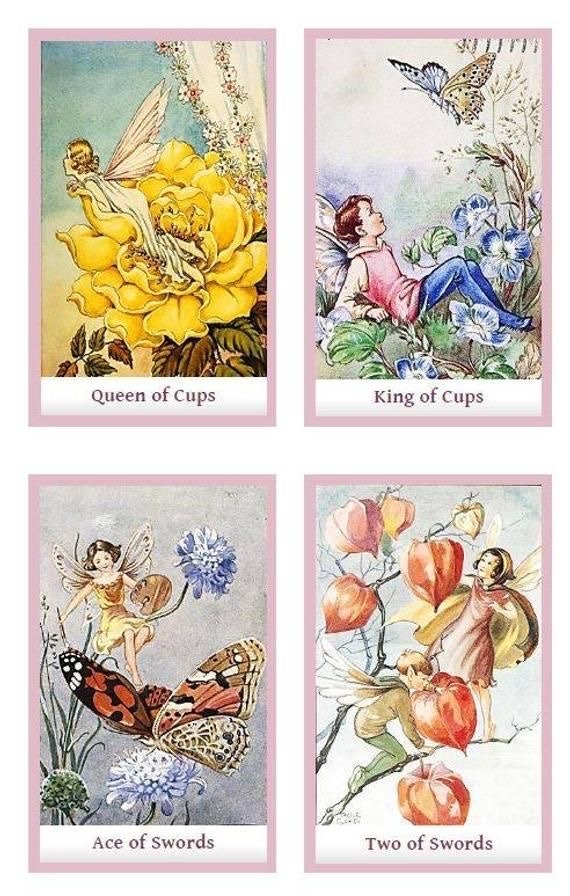
Fae Storytelling: Spend some time reading or writing fairy tales and folklore. Immerse yourself in the magical stories of fairies, gnomes, and other mythical creatures. You could also gather with friends or family and take turns sharing your own fae inspired tales.

Fae-inspired Treats: Whip up some fairy-themed treats to indulge in on Fae Fridays. Decorate cupcakes with edible flowers, create fairy-shaped cookies, or brew a cup of floral-infused tea to enjoy as you.
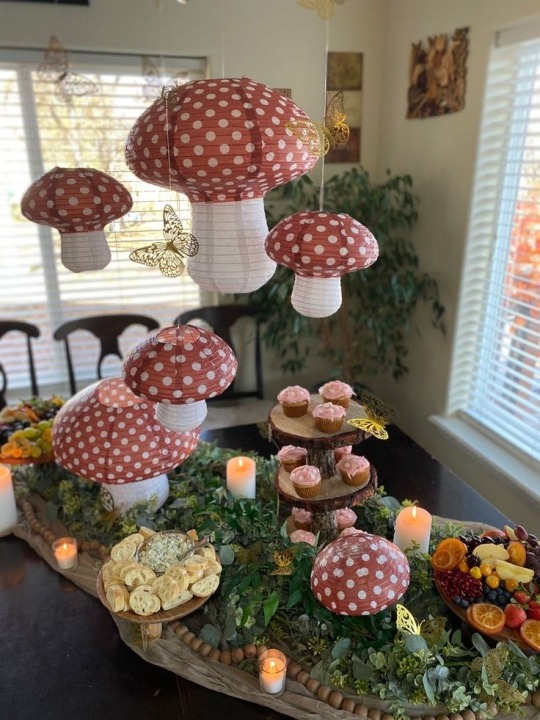
Remember, Fairy Fridays are a time to celebrate and honor the otherworld/fairyland. I hope I’ve inspired you to let your creativity and imagination guide you to infuse your Fridays with faery magic. Embrace the whimsy, playfulness, and joy that the fairies bring into your life.
Feel free to share your Fae Friday experiences and ideas. 🌺🧚♀️✨
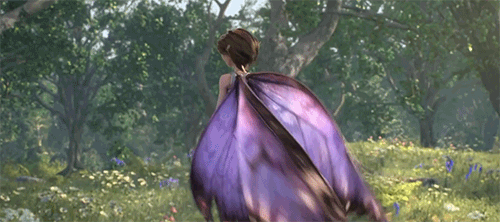
~Fae
#fairycore#faerie folklore#faery#fairy witchcraft#fairy witch#witchblr#pagan#paganism#witch#witchcraft#fae#fae friday#fairy friday#naturecore#cottagecore#fairies#fairy faith#fairy aesthetic#faerie faith
22 notes
·
View notes
Text
A lesson in Trees and Gloaming Etiquette
I fucked up. Like I found a solution to the problem but I done fucked up because I got too excited. You see, I hiked out to a bird sanctuary on my last off day in Chicago and came across a beautiful Hawthorn tree, surrounded by Elder and Bittersweet Nightshade with a nest in it. It's easily one of the most obvious and clear signs of a tree of the fairfolk. And of course, I work closely with the Lordly Hawthorn as it is my patron tree.


So what was my mistake? I broke a branch of green wood, attempting to harvest thorns. I got greedy. I had absolutely asked permission, but rather than waiting for guidance on where to start I immediately went for a low lying branch of thorns and green haws and took the leaves ans thorns from there, breaking part of the branch. Only to look down and see the wind blown branch of thorns freely given to me and realized my horrible etiquette.
According to Schulke's Viridium (an excellent book on the way of cain if I might add), fae-owned Hawthorn trees should be revered and only the wind blown and already fallen boughs of the tree should be taken. I was deeply embarrassed by my faux pa. Immediately after taking the thorns, I made an offering of part of my water rations from the hike and blood with my deepest apologies. But, it still wasn't enough as the omen of the dead Cedar Wax Wing on my way back clearly drove me to pull some cards when I got home.

The cards confirm my suspicions, that blood and water were not enough. I had to return part of my harvest, specifically the greenery and thorns from the branch I broke. But what interested me was the fact that that according to the cards, I had to bury the thorns and be creative with it. After sitting with the cards I realized I still had some Hawthorn dyed paper with me, and wrote out a petition of apology to the arboreal spirit, bundling the thorns and leaves with an offering of cantrip powder alongside. I confirmed this was the right move with my cards and then realized that as part of my penance, I could write about the experience as well.
So, let this be a lesson. Don't just ask permission from a plant, but wait for a positive response. Don't go breaking branches off sacred trees. And if you are going to violete some etiquette of the Good Neighbors, be prepared to make some heavy sacrifices with that apology.
#faerie faith#good neighbors#gloamimg folk#folk magic#charms#traditional witchcraft#herbalism#hawthorn#tw dead animal#tw death
22 notes
·
View notes
Text
Any spirit of pagan provenance which had escaped wholesale assimilation into the Christian pantheon was officially defined as an a "evil spirit" by most contemporary theologians. In this context, any dealings with such spirits were theoretically a betrayal, or in other words, a "renunciation" of the true faith. Such a negative equation was intensified by the fact that fairies, on their part, were often considered hostile towards Christianity. An anecdote recorded in Scotland at the beginning of the eighteenth century describes how a brownie was displeased when his master read the Bible (Martin 1970, 392). Robert Kirk describes this fairy hostility in more detail, claiming that the fairies have:
no discernible Religion, Love, or Devotione towards God the Blessed Maker of all. They disappear whenever they hear his name invocked, or the name of Jesus... nor can they act ought at that time, after hearing of that Sacred Name (Sanderson 1976, 56).
Many early modern individuals must have been aware, to a greater or lesser degree, of these mutual hostilities, and if they wished to avail themselves of fairy powers they must have circumnavigated this problem in some way. Their solutions may not have differed greatly from those used in later centuries by people who believed in fairies. In the nineteenth century, for example, when at sea, fishermen on the Moray Firth:
would never mention such words as Church or manse or minister. Any utterance suggestive of the new faith would be displeasing to the ancient god of the ocean, and might bring disaster upon the boat (McPherson 1929, 70).
By their silence the fishermen were, for the duration of their journey, making a superficial show of putting aside their Christian allegiances in return for the protection and goodwill of the ancient god of the ocean. It is not difficult to imagine how, in a different century and different context, this and other types of diplomacy towards non Christian powers could have been interpreted as a direct renunciation of Christianity.
- The Witch's Familiar and the Fairy in Early Modern England and Scotland, Emma Wilby (2014).
50 notes
·
View notes
Text
People must believe what they can, and those who believe more must not be hard upon those who believe less.
- the Great-Great-Grandmother (George MacDonald's The Princess and the Goblin, Chapter XXII)
Welcome anyone who is weak in faith […] Let us no longer judge one another, but rather resolve never to put a stumbling block or hindrance in the way of a brother.
the Epistle of Saint Paul to the Romans (14:1a, 13)
#Christianity#George MacDonald#Saint Paul#faith#skepticism#awe#faerie#faerie tale#Epistle to the Romans#compassion
9 notes
·
View notes